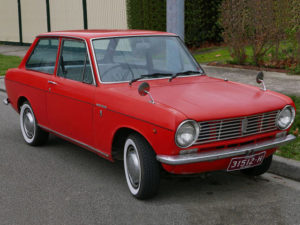
The Datsun 1000 models were equipped with 1.0 L Straight-four engine A10. Bore and stroke were 73.0 mm and 59.0 mm, respectively. Compression ratio rating was 8.5:1. The A10 engine produced 61 HP (45.5 kW, 62 PS) of horsepower at 6,000 rpm and 83.4 Nm (61.5 ft-lb) of torque at 4,000 rpm (models for Europe and North America).
In September 1969, the Datsun 1000 Coupe was introduced for the Australian market. This model was equipped with an updated version of the A10 with a new carburetor and increased to 9.0:1 compression ratio. This motor produced 65 HP (66 PS, 49 kW) of horsepower and 89 Nm (66 ft-lb) of torque.
Engine Specifications
| Datsun 1000 Engine Specifications | ||
| Engine code | A10 | |
| Layout | Four stroke, Inline-4 (Straight-4) | |
| Fuel type | Gasoline (petrol) | |
| Displacement | 1.0L, 988 cc (60.3 cu in) | |
| Cylinder block alloy | Cast iron | |
| Cylinder bore | 73.0 mm (2.87 in) | |
| Piston stroke | 59.0 mm (2.32 in) | |
| Compression ratio |
8.5:1 9.0:1 for Datsun 1000 Coupe (Australia) |
|
| Valve Arrangement: | SOHC, chain drive | |
| Valves: | 8 (2 valves per cylinder) | |
| Intake valve timing: |
Open: 12° B.T.D.C. Close: 48° A.T.D.C. |
|
| Exhaust valve timing: |
Open: 50° B.T.D.C. Close: 10° A.T.D.C. |
|
| Intake valve head diameter: | 37.0 mm (1.457 in) | |
| Exhaust valve head diameter: | 30.0 mm (1.181 in) | |
| Fuel system | Carburetor | |
| Power output |
61 HP (45.5 kW, 62 PS) at 6,000 rpm 65 HP (66 PS, 49 kW) at 6,000 rpm (Datsun 1000 Coupe, Australia) |
|
| Torque output |
83.4 Nm (8.5 kgm, 61.5 ft-lb) at 4,800 rpm 89 Nm (9.0 kgm, 66 ft-lb) at 4,800 rpm (Datsun 1000 Coupe, Australia) |
|
| Firing order | 1-3-4-2 | |
| Engine weight | 91.5 kg (210.5 kg) | |
Top speed and fuel consumption
| Top speed and Fuel consumption | |
| Top speed | 130 km/h / 81 mph |
| Fuel consumption (city) | – |
| Fuel consumption (highway) | – |
| Fuel consumption (combined 50/50) | – |
Maintenance data
| Valve clearance (Cold) | |
| Intake valve | 0.25 mm (0.0098 in) |
| Exhaust valve | |
| Valve clearance (Hot) | |
| Intake valve | 0.35 mm (0.0138 in) |
| Exhaust valve | |
| Compression pressure | |
| Standard | 12.7 kg/m2 (181 psi) / 350 rpm |
| Minimun | 10.0 kg/m2 (142 psi) / 350 rpm |
| Oil system | |
| Oil consumption , L/1000 km (qt. per miles) | up to 0.5 (1 qt. per 1200 miles) |
| Recommended engine oil | 5W-30, 5W-40, 10W-30, 10W-40 |
| Engine oil capacity (Refill capacity) |
Max.level 3.2 l (3.4 qt.) Min.level 2.2 l (2.4 qt.) |
| Oil change interval, km (miles) | 5,000-10,000 (3,000-6,000) |
| Coling system | |
| Coolant capacity |
3.8 L (with heater 4.5 l) Radiator size: 2.0 L Engine size: 1.8 L |
| Ignition system | |
| Ignition coil | Hitachi C14-51 / Mitsubishi HP5-10E |
| Distributor | Hitachi D412-53 / Mitsubishi TVA-4F1L |
| Ignition timig B.T.D.C./rpm | 8°/600-700 |
| Spark plug | Hitachi L45 / NGK B-E |
| Spark plug thread | 14 mm (0.55 in) |
| Spark plug gap | 0.7 – 0.8 mm (0.027 – 0.031 in) |
| Carburetor | |
| Type | Hitachi DCG 286-3 |
| Throttle valve bore | 26 mm (1.02 in) |
| Venturi size | 20 x 7 mm (0.78 x 0.27 in) |
| Main jet | #95 |
| Slow jet | #80 |
| Power jet | #60 |
| Generator | |
| Type | Hitachi LT125-01 / Mitsubishi AS2025A-1 |
| Voltage regulator | Hitachi TL1Z-10A / Mitsubishi RL2220B5 |
| Starter | |
| Type | Hitachi S114-87 / Mitsubishi MW-V1R |
Be the first to comment